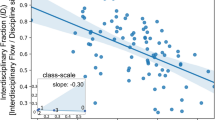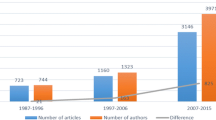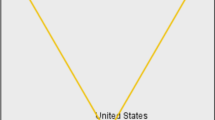Abstract
The theory of citations should not consider cited and/or citing agents as its sole subject of study. One is able to study also the dynamics in the networks of communications. While communicating agents (e.g., authors, laboratories, journals) can be made comparable in terms of their publication and citation counts, one would expect the communication networks not to be homogeneous. The latent structures of the network indicate different codifications that span a space of possible “translations”. The various subdynamics can be hypothesized from an evolutionary perspective. Using the network of aggregated journal-journal citations inScience & Technology Studies as an empirical case, the operation of such subdynamics can be demonstrated. Policy implications and the consequences for a theory-driven type of scientometrics will be elaborated.
Similar content being viewed by others
References
A. J. Lotka, The frequency distribution of scientific productivity,Journal of the Washington Academy of Sciences, 16 (1926) No. 12, 317–323.
D. de Solla Price, A general theory of bibliometric and other cumulative advantage processes,Journal of the American Society for Information Science, 27 (1976) No. 5/6, 292–306.
P. Bak, K. Chen, Self-organized criticality,Scientific American, January 1991, 26–33.
H. R. Maturana, Biology of language: The epistemology of reality. In:G. A. Miller, E. Lenneberg (Eds),Psychology and Biology of Language and Thought. Essays in Honor of Eric Lenneberg, Academic Press, New York etc., 1978, pp. 27–63.
R. S. Burt,Toward a Structural Theory of Action, Academic Press, New York etc., 1982.
T. J. Pinch, Towards an analysis of scientific observations: The externality and evidential significance of observational reports in physics,Social Studies of Science, 7 (1985) 3–36.
O. Amsterdamska, L. Leydesdorff, Citations: Indicators of significance,Scientometrics, 15 (1989) 449–471.
A. Giddens,Central Problems in Social Theory, Macmillan, London, 1979.
G. Dosi, Technological paradigms and technological trajectories: A suggested interpretation of the determinants and directions of technical change,Research Policy, 12 (1982) 299–316.
M. Callon, B. Latour, Unscrewing the big Leviathan: how actors macro-structure reality and how sociologists help them to do so. In:K. D. Knorr-Cetina, A. V. Cicourel (Eds),Advances in Social Theory and Methodology. Toward an Integration of Micro-and Macro-Sociologies, Routledge & Kegan Paul, London, 1981, pp 277–303.
R. R. Nelson, S. G. Winter,An Evolutionary Theory of Economic Change, Belknap Press of Harvard University Press, Cambridge MA, 1982.
G. Blauwhof, Non-equilibria dynamics and the sociology of technology. In:Leydesdorff, Van den Besselaar,38 pp. 152–166.
N. Luhmann,Die Wissenschaft der Gesellschaft, Suhrkamp, Frankfurt a. M., 1990.
M. Gibbons, C. Limoges, H. Nowotny, S. Schwartzman, P. Scott, M. Trow,The New Production of Knowledge: The Dynamics of Science and Research in Contemporary Societies, Sage, London, 1994.
L. Leydesdorff, The evolution of communication systems,Systems Research and Information Science, 6 (1994) 219–230.
B. Latour,The Pasteurization of France, Harvard University Press, Cambridge MA/London, 1988.
L. Leydesdorff, Uncertainty and the communication of time,Systems Research, 11 (1994) No. 4, 31–51.
H. A. Simon, The organization of complex systems. In:H. H. Patiee (Ed.),Hierarchy Theory: The Challenge of Complex Systems, George Braziller, New York, 1973, pp. 1–27.
C. Kampmann, C. Haxholdt, E. Mosekilde, J. D. Sterman, Entrainment in a disaggregated long-wave model. In:Leydesdorff, Van den Besselaar, 38 pp. 109–124.
L. Leydesdorff,The Challenge of Scientometrics: The Development, Measurement and Self-Organization of Scientific Communications, DSWO Press, Leiden University, Leiden, 1995.
Y. Elkana, J. Lederberg, R. K. Merton, A. Thackray, H. Zuckerman,Toward a Metric of Science, Wiley, New York etc., 1978.
H. Small, E. Sweeney, E. Greenlee, Clustering the Science Citation Index using co-citations II. Mapping science,Scientometrics, 8 (1985) 312–340.
P. Van den Besselaar, L. Leydesdorff, Mapping change in scientific specialties: A scientometric reconstruction of the development of artificial intelligence,Journal of the American Society for Information Science, 47 (1996) 415–436.
L. Leydesdorff, The relations between qualitative theory and scientometric methods in science and technology studies,Scientometrics, 15 (1989) 333–347.
B. R. Martin, J. Irvine, Assessing basic research: Some partial indicators of scientific progress in radio astronomy,Research Policy, 12 (1983) No. 2, 61–90.
H. F. Moed, et al., The use of bibliometric data for the measurement of university research performance,Research Policy, 14 (1985) 131–149.
H. Chang, D. Dieks, The Dutch output of publications in physics,Research Policy, 5 (1976) 380–396.
L. Leydesdorff, Towards a theory of citation. A reaction to MacRoberts & MacRoberts,Scientometrics, 12 (1987) 287–291.
U. Beck,Die Risiko-Gesellschaft, Suhrkamp, Frankfurt a. M., 1986.
D. R. Hofstadter,Gödel-Escher-Bach: An Eternal Golden Braid, Basic Books, New York, 1979.
D. E. Rumelhardt, J. L. McClelland, and the PDP Research Group,Parallel Distributed Processing, MIT Press, Cambridge/MA, 1986.
E. S. Andersen,Evolutionary Economics. Post-Schumpeterian Contributions, Pinter, London, 1994.
F. Narin, D. Olivastro, Status report: Linkabes between technology and science,Research Policy, 2l
S. Katz, D. Hicks, M. Sharp, B. R. Martin,The Changing Shape of British Science, SPRU Special Report No. 3., Brighton, 1995.
G. Blauwhof,The Non-linear Dynamics of Technological Developments: An Exploration of Telecommunications Technology, Ph.D. Thesis, University of Amsterdam, Amsterdam, 1995.
R. Barras, Interactive hmovation in financial and business services: The vanguard of the service revolution,Research Policy, 19 (1990) 215–237.
L. Leydesdorff, H. Etzkowitz, Emergence of a triple helix of university-industry-government relations,Science and Public Policy, (forthcoming; October 1996).
L. Leydesdorff, P. Van den Besselaar, Eds,Evolutionary Economics and Chaos Theory: New directions for technology studies, Pinter, London, 1994.
Author information
Authors and Affiliations
Rights and permissions
About this article
Cite this article
Leydesdorff, L., Van Den Besselaar, P. Scientometrics and communication theory: Towards theoretically informed indicators. Scientometrics 38, 155–174 (1997). https://doi.org/10.1007/BF02461129
Received:
Issue Date:
DOI: https://doi.org/10.1007/BF02461129




